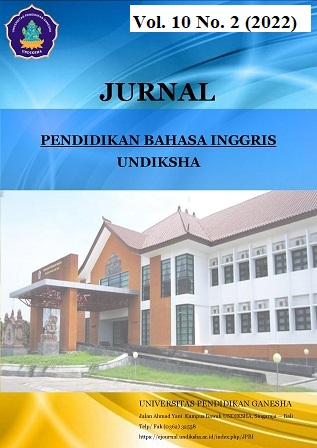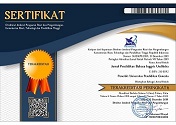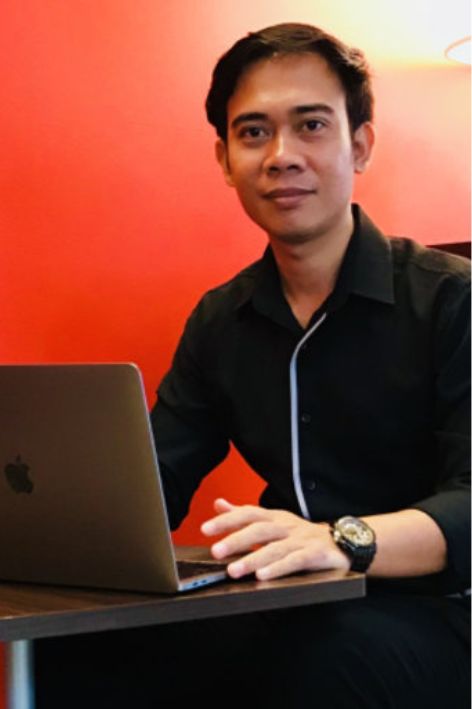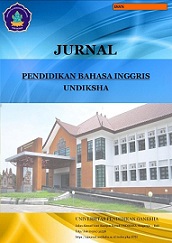Lexicons of Song Used in Palawakya Dance
DOI:
https://doi.org/10.23887/jpbi.v10i2.57105Keywords:
Lexicons, Word Class, Lexical Meaning, Palawakya DanceAbstract
Palawakya dance is one of the traditional dances in Bali. The accompaniment of the dance is a set of gong kebyar, one of the typical of Balinese gong music. The present study aimed to analyses lexical meaning of the song lyrics of the dance, the kind of language used in the song, the typical of lexicons and their word clasess. This descriptive qualitative study applied observing, interviewing, and documentation techniques to find its study data. This study using three instruments including the researcher, observation sheet, and interview guide were used to collect the obtained data of this study. The subjects of the study were the ones who are experts in singing of song performed in the Palawakya dance. The object of the study is the lexicons which exist in the song of the dance. The study results show that the song used in the dance tells the story of Rama's journey at the boarding school in Ayodhya Kingdom to learn self defense in an attempt to destroy his annoying enemies. There were 11 lexicons in the song and all of them are classified into noun class of word. This study implicates to the contribution to language preservation. Moreover, it can be a reminder that some certain lexicons are endangered so the involvement of both government and society is needed.
References
Adnyana, P. E. S., & Prayoga, I. M. A. (2021). Pengenalan Seni Suara Dharmagītā “Sekar Agung” Berbasis Multimedia Interaktif. Sphatika: Jurnal Teologi, 12(1), 62–75. https://doi.org/10.25078/sphatika.v12i1.1266.
Al-Qutaiti, Y. O. (2019). Teaching and learning lexical items. IMPACT: International Journal of Research in Humanities, Arts and Literature, 7(5), 271–276. http://www.impactjournals.us/download/archives/27-05-2019-1558955050-6-IMPACT : IJRHAL-24. Teaching_and_Learning_Lexical_Items_-2019-05-25-05-13.pdf.
Amaliah, T. H. (2016). Nilai-Nilai Budaya Tri Hita Karana dalam Penetapan Harga Jual. Jurnal Akuntansi Multiparadigma, 6, 189–206. https://doi.org/10.18202/jamal.2016.08.7016.
Ambariski, R. (2012). The Analysis of Fantasy Genre’s Formula on Harry Potter Series. Lexicon, 1(1), 90–103. https://doi.org/10.22146/lexicon.v1i1.5312.
Angkasa, I. W. (2001). Singing and interpreting Kakawin. Contemporary Theatre Review, 11(2), 37–44. https://doi.org/10.1080/10486800108568622.
Astuti, N. N. S., Ginaya, G., & Susyarini, N. P. W. A. (2019). Designing Bali tourism model through the implementation of tri hita karana and sad kertih values. International Journal of Linguistics, Literature and Culture, 5(1), 12–23. https://pdfs.semanticscholar.org/21ef/598b50c4e58031e853a4fc07197a4db0a8dd.pdf.
Bimantara, P., Pratama, P. D. A., & Wismanjaya, K. A. (2019). How Culture Resources Developed As A New Tourism Destination In Buleleng Regency. In International Conference on Tourism, Economics, Accounting, Management, and Social Science (TEAMS 19), 308–315. https://doi.org/10.2991/teams-19.2019.53.
Boddaert, G., Cornut, C., & Casalis, S. (2021). Integration of newly learned L2 words into the mental lexicon is modulated by vocabulary learning method. Acta Psychologica, 212, 103220. https://doi.org/10.1016/j.actpsy.2020.103220.
Budasi, I. G., & Satyawati, M, S. (2021). An Ethnolinguistics Perspective on Lexicons of Traditional House in Menyali Village,North Bali. Journal of Bali Studies, 11(2), 115–130. https://ojs.unud.ac.id/index.php/kajianbali/article/view/68203/39061.
Crystal, D. (2008). A Dictionary of Linguistics and Phonetic. Blackwell Publishing.
Dewi, A. A. I. M. D. U., Gede Budasi, I., & Suarnajaya, I. W. (2020). Lexicons in Legong Keraton dance. Lingua Scientia, 27(2), 98–107. https://doi.org/10.23887/ls.v27i2.26422.
Faruq, Sabani, N., Sukarno, A., & Purwandari, E. (2021). Systematic Literature Review: Psychological Concepts Of Learning In Handling Speaking Delay In Early Children. Jurnal Penelitian Humaniora, 23(1), 45–54. https://doi.org/10.23917/humaniora.v23i1.19126.
Fatimatuzzakrah, F., Suktiningsih, W., & Hastuti, H. (2020). The Cultural Value of Lexicon in “Ngendang” Tradition. Kajian Linguistik Dan Sastra, 5(1), 1–13. https://journals.ums.ac.id/index.php/KLS/article/view/10425.
Giri, I. M. A. (2017). Pelestarian Bahasa, Aksara, dan Sastra Bali Melalui Pengoptimalan Tripusat Pendidikan. Purwadita, 1(1), 27–32. https://stahnmpukuturan.ac.id/jurnal/index.php/Purwadita/article/download/6/5.
Gunada, I. W. A. (2021). Struktur teks Geguritan Candrabherawa dalam tradisi tulis bahasa Bali. Aksara: Jurnal Bahasa Dan Sastra, 22(2), 140–156. http://jurnal.fkip.unila.ac.id/index.php/aksara/article/view/20892.
Huda, N. L. A., & Ma’mun, N. (2020). The Anxiety of EFL Students in Presentation. Elitejournal.Org, 2(1), 65–84. http://elitejournal.org/index.php/ELITE/article/view/31.
Kusuma, I, M, A, W., Budasi,, I, G., & Suarnajaya, I, W. (2020). Lexicons of tabuh Rah used in menyali vilage. Jurnal Bahasa,Seni, Dan Pengajarannya, 15(2). https://doi.org/10.23887/prasi.v15i02.26906.
Mantiri, O. (2015). Factors Affecting Language Change. SSRN Electronic Journal, March 2010. https://doi.org/10.2139/ssrn.2566128.
Muada, I. K., & Sugama, I. W. (2020). Pelestarian Vokal Tembang Bali Dengan Media Radio Pancar Ulang Di Era Covid-19. Widyadari: Jurnal Pendidikan, 21(2), 615–626. https://doi.org/10.5281/zenodo.4049419.
Mulyawan, I. W. (2021). Maintaining and revitalising Balinese language in public space: A controversial language planning regulation. Indonesia and the Malay World, 49(145), 481–495. https://doi.org/10.1080/13639811.2021.1910356.
Murniti, N. W. (2019). Nilai Pendidikan Relegi Dalam Sekar Rare. Widyacarya: Jurnal Pendidikan, Agama Dan Budaya, 3(1), 57–64. https://www.jurnal.stahnmpukuturan.ac.id/index.php/widyacarya/article/viewFile/211/204.
Putra, I. G. N. A. (2020). Nilai Pendidikan Karakter Yang Terkandung Dalam Tembang Bali. Kalangwan Jurnal Pendidikan Agama, Bahasa Dan Sastra, 10(1), 65–70. https://doi.org/10.25078/klgw.v10i1.1397.
Putri, I. G. A. M. A. D., & Wirawati, N. G. P. (2020). Influence of Intellectual/Emotional/Spiritual Intelligence, Independence, and Tri Hita Karana on Auditor Performance. Jurnal Ilmiah Akuntansi Dan Bisnis, 15(1), 85. https://doi.org/10.24843/jiab.2020.v15.i01.p08.
Putri, I. G. A. V. W., & Santika, I. D. A. D. M. (2020). The Emotional Lexicon Used by Male and Female Communication: Study of Balinese Language Used in South Kuta-Bali. Linguistic, English Education and Art (LEEA) Journal, 3(2), 364–372. https://doi.org/10.31539/leea.v3i2.1177.
Qiong, O. U. (2017). A brief introduction to perception. Studies in Literature and Language, 15(4), 18–28. https://doi.org/10.3968/10055.
Raharja, M. A., Adiatmika, I. P. G., Adiputra, I. N., Purnawati, S., & Supriana, I. W. (2022). Implementasi Metode Mel-Frequency Cepstral Coefficient Dan Dtw Pada Aplikasi Pengenalan Suara Tembang Sekar Alit. Jurnal RESISTOR (Rekayasa Sistem Komputer), 5(1), 65–71. https://doi.org/10.31598/jurnalresistor.v5i1.1081.
Rohbiah, T. S. (2020). An analysis of Semantic changes of English lexical borrowings in Indonesia Tourism field. Loquen: English Studies Journal, 13(1), 40. https://doi.org/10.32678/loquen.v13i1.2554.
Roy, S., & Roth, D. (2015). Solving general arithmetic word problems. Conference Proceedings - EMNLP 2015: Conference on Empirical Methods in Natural Language Processing, 1743–1752. https://doi.org/10.18653/v1/d15-1202.
Seriadi, S. L. N. (2017). Pembentukan Karakter Unggul Dan Nasionalis Pada Anak Usia Dini Melalui Sekar Rare. Pratama Widya: Jurnal Pendidikan Anak Usia Dini, 2(2), 31–38. https://doi.org/10.25078/pw.v2i2.1013.
Suwija, I. N. (2017). Identification of anggah-ungguh kruna Balinese language. International Journal of Linguistics, Literature and Culture, 3(5), 14–21. https://doi.org/10.21744/ijllc.v3n6.2.
Suwonsichon, S. (2019). The Importance of Sensory Lexicons for Research and Development of Food Products. Foods, 8(1), 27. https://doi.org/10.3390/foods8010027.
Swarniti, N. W. (2021). The Meaning of The Verb “Destroy” in the Balinese Language: A Natural Semantic Meta Language Approach. Humanis: Journal of Arts and Humanities, 25(3), 292–298. https://ojs.unud.ac.id/index.php/sastra/article/download/72920/41009.
Yayuk, R. (2018). Lexicon of Characteristic Disclosure of River Culture at Banjarmansin and Nagara Societies: An Ethnosemantic Study. Naditira Widya, 12(2), 131–146. https://doi.org/10.24832/nw.v12i2.312.
Downloads
Published
Issue
Section
License
Copyright (c) 2023 Putu Diandra Dama Suri, I Gede Budasi, Putu Eka Dambayana

This work is licensed under a Creative Commons Attribution-ShareAlike 4.0 International License.
Authors who publish with the Jurnal Pendidikan Bahasa Inggris Undiksha agree to the following terms:- Authors retain copyright and grant the journal the right of first publication with the work simultaneously licensed under a Creative Commons Attribution License (CC BY-SA 4.0) that allows others to share the work with an acknowledgment of the work's authorship and initial publication in this journal
- Authors are able to enter into separate, additional contractual arrangements for the non-exclusive distribution of the journal's published version of the work (e.g., post it to an institutional repository or publish it in a book), with an acknowledgment of its initial publication in this journal.
- Authors are permitted and encouraged to post their work online (e.g., in institutional repositories or on their website) prior to and during the submission process, as it can lead to productive exchanges, as well as earlier and greater citation of published work. (See The Effect of Open Access)













